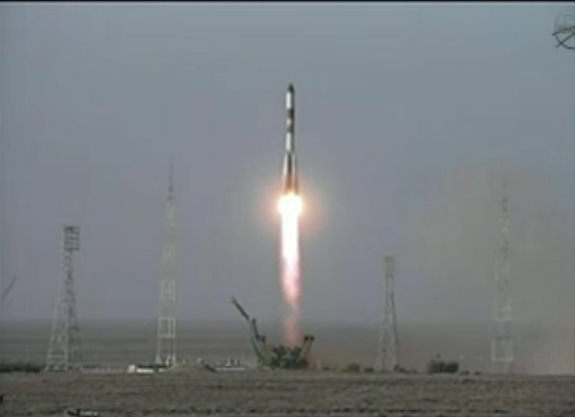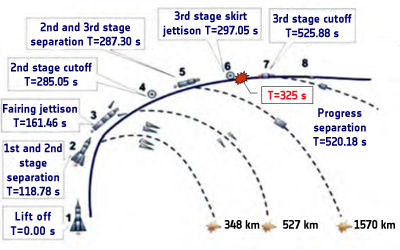[/caption]
The first launch of a Russian resupply ship since the August failure and crash of the Progress/SoyuzU is scheduled for Sunday, October 30, 2011 at 6:11 a.m. EDT (10:11 GMT). The importance of a successful launch looms large for the future of the International Space Station.
“Because the previous Progress didn’t get to orbit, it is important this launch go as planned,” NASA spokesman Kelly Humphries told Universe Today. “The booster we use to launch the crews, while not identical, is very similar to the one used for Progress — in particular the third stage where the failure was identified, so we do look forward to our Russian partners having a successful launch on Sunday.”
If not, the space station faces the prospect of being de-crewed.
This first post-shuttle era launch of a Progress cargo ship abruptly ended at about six minutes into the flight on August 24, 2011 when an engine anomaly prompted a computer to shutdown an engine, just before the third stage of the Soyuz rocket ignited. The rocket and ship crashed to Earth in eastern Russia.
Progress 45 is now set to launch from the Baikonur Cosmodrome in Kazakhstan on Sunday and hopefully deliver 2.8 tons of food, fuel and supplies to the space station crew members.

If that launch goes as planned, that would allow the Soyuz TMA-22 spacecraft carrying three new station crew members to launch in mid-November. Flight Engineers Dan Burbank, Anton Shkaplerov and Anatoly Ivanishin are scheduled to join the current on-orbit crew of Commander Mike Fossum and Flight Engineers Satoshi Furukawa and Sergei Volkov on Nov. 16.
Fossum and his crew are due to end their stay at the station on Nov. 21, so if the Soyuz TMA-22 can’t launch before then, the ISS will be left crewless.
While the Soyuz rockets and Progress cargo ships have had a long history of successes, this one failure – coming just after the space shuttles were retired – has left the ability to get new crews to the space station in limbo. The Progress cargo ships launch on a Soyuz-U rocket, while the Soyuz crew capsules, — the Soyuz TMA — launches on a Soyuz-FG. The third stages of the two rockets are virtually identical.
A Russian commission investigating the Progress failure said the crash was caused by a malfunction in the rocket’s third stage engine gas generator. The commission the malfunction was the result of an accidental manufacturing flaw. The third stages of all Soyuz-type rockets have been changed out, and a Soyuz rocket did launch successfully on October 21 from the ESA’s new launch facility in French Guiana, carrying new GPS satellites.
The Soyuz-U rocket has had 745 successful launches and just 21 failures over nearly four decades. The Soyuz-FG has had 25 launches, all successful.
“Because of the failure and similarity of the launch vehicles, we have been performing a lot of preliminary planning and work to make sure that in the unlikely event the Progress were to have another problem,” Humphries said, “that we would be able to get the existing crew home safely and be able to operate the International Space Station and conduct research there without the crew on board.”
Humphries said the ISS team has identified many issues so that they would be capable of operating the space station almost indefinitely without a crew.
“Of course that is not the preference because it would have some impacts on our research,” he said. “But we are very confident that our Russian partners have done their due diligence and identified the root cause and taken the right steps to correct this and we are looking forward to having a good launch.”
Humphries said despite the challenges of working with potentially having to de-crew the ISS, the space station program and partnerships are still strong.
“The international partnerships we’ve developed with our colleagues in Russia, Canada, Japan and Euorpe are probably one the greatest achievements of the ISS program,” Humphries said. “We back each other up on a variety of operational and other fronts on a daily basis. For example, our Russian colleagues were instrumental in keeping the space station operational following the Columbia accident in 2003.”
The launch and also the Progress docking to the ISS will be carried live on NASA TV.


Got to love those disintegrating totem poles. I suspect Von Braun, Willi Ley and Mr. Heinlein would be sorely disappointed with the state of Rocketry in the 21st century.
Got anything else that will reach orbital velocity without squishing the crew? There was an interesting point made on rocket engineering in an article about reusable spacecraft. You can’t easily identify problems and develop fixes because every launch is with a newly built craft which is then thrown away. Imagine having a brand new car every time you took a drive, how long it would be before you got a lemon? Once spacecraft start being reusable then they will be tinkered, tweaked adjusted revamped and become more reliable, just like aircraft. Meanwhile keep working on your amorphous diamond Mach25 scramjet.
Agreed. (Though it seems the UK air breather just may be technologically if not commercially viable.)
To vent, what gets my goat isn’t the throwaway stacks but the candles. I’ll bet the ninth century chinese would be surprised if we still shot solid rocket-propelled arrows to the skies.
Sigh, it is like nuclear reactors. We have elegant photovoltaics, yet we find that boiling water is the way to make the energy market affordable.
Those elegant photovoltaics need to find a way into orbit. No matter their efficiency, being able to “run” only 1/2 a day, at best, is a real downgrade. I don’t need part time electricity. I need electricity too cheap to meter.
The original Atlas was closer to being a SSTO, as two engines were jettisoned rather than an entire stage, than anything we’ve built since.
It is rumored that the Saturn V was overbuilt (by 10%) and the F-1s, underdriven (run at 96%), that a modern version, built of modern materials (reduced mass), could place a 2000 – 3000kg module into orbit using just one stage. Perhaps inefficient, but it would be SSTO. We need to start somewhere.
The USAF has a missile, launched from (F-15, F-111) that can reach orbit. Scale up to a 747 launching a piggyback load at 16000 meters.
Much of the fuel is used just to get moving. Build a hydraulic launch platform that lifts the entire rocket at .33m/sec, just as the engines fires.
I’m out of ideas, but I, for one, would welcome Atomic Rockets launching from the South Pacific. Whether an updated NERVA design, or a 100,000 metric ton “bell” (Footfall, Niven/Pournelle) riding the wave front of exploding fusion bombs.
Virgin galactic is piggyback but only suborbital, when I first saw a shuttle on the back of a jumbo I thought that was how they were going to launch it… I thought about pipping some of these i-phone space amateurs with balloons by hanging a small rocket off the balloon, When the balloon bursts in the stratosphere the rocket fires and becomes the first amateur sputnik, history made, unfortunately there is a big difference between escape velocity and orbital speed, I didn’t realise how fast Newton’s cannonball needs to be travelling to not fall back, Quite a large rocket is still required and the balloon size gets silly..
Bad enough that we’re down to a crew of three…. the science on board would definitely suffer if the ISS were left unmanned.
Meanwhile – GO SpaceX!
zhelayu udachi
will there be a live stream for this launch?
Yes, NASA TV will carry the launch live. I’ve added the link to the bottom of the article.
Progress M-13M flying the 45P mission (NOT Progress 45). In the same way it was always STS (or Soyuz) X carrying the Expedition Y crew.